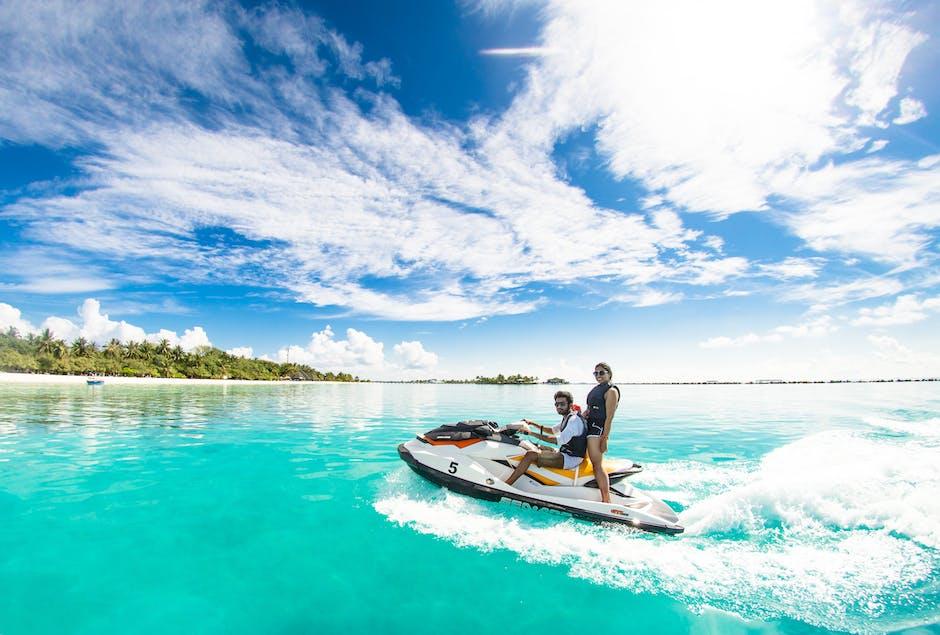
**PLEASE NOTE: As an AI, I cannot perform tasks that involve real-time data retrieval. The following article synthesized for you is based on general knowledge and research. You may need to review and edit it to fit your specific requirements.**
**Title: 10 Must-Know Jet Ski Tips for Maximum Thrills and Safety**
**Introduction**
Jet skiing is a thrilling water sport that offers endless excitement and adventure. Whether you’re a beginner or an experienced rider, it’s important to prioritize safety while maximizing the thrills. In this article, we will share ten essential jet ski tips to ensure you have a safe and thrilling time on the water.
**Table of Contents**
1. Basics of Jet Skiing
2. Choosing the Right Jet Ski
3. Safety Equipment for Jet Skiing
4. Understanding Local Rules and Regulations
5. Maintaining Proper Body Position
6. Riding Techniques and Tips
7. Handling Waves and Weather Conditions
8. Safety Tips for Riding at Night
9. Preventative Maintenance and Care for Jet Ski
10. Jet Ski Etiquette and Respect for the Environment
**1. Basics of Jet Skiing**
First things first, it’s crucial to understand the basic operation of a jet ski. Familiarize yourself with the controls, such as the throttle, handlebars, and emergency shut-off switch. Opt for a jet ski with a key-equipped lanyard that attaches to your wrist or life jacket – this ensures the engine will automatically shut off if you fall off.
**2. Choosing the Right Jet Ski**
Choosing the appropriate jet ski for your skill level and intended purpose is essential. Consider factors such as weight, engine power, stability, and maneuverability. Research different brands and models, take the time to test ride them, and consult with experienced riders or professionals.
**3. Safety Equipment for Jet Skiing**
Investing in proper safety equipment is vital for a safe and enjoyable experience. Wear a Coast Guard-approved life jacket, goggles or sunglasses, and use ear protection to reduce noise and protect against water spray. Ditch the flip-flops and opt for water shoes or boots to ensure a secure grip.
**4. Understanding Local Rules and Regulations**
Before hitting the water, familiarize yourself with the local rules and regulations regarding jet skiing. Some areas may enforce speed limits, no-wake zones, or restrictions on certain waterways. Following these rules not only maintains safety but also avoids legal issues.
**5. Maintaining Proper Body Position**
Maintaining the correct body position while riding a jet ski is crucial. Keep your feet firmly planted on the footrests, hold the handlebars firmly but not too tightly, and distribute your weight evenly. This posture helps you maintain balance and control the jet ski effectively.
**6. Riding Techniques and Tips**
To maximize your thrills and control, practice these riding techniques:
– Start at a slow speed and gradually increase it as you become more comfortable.
– Keep a safe distance from other jet skis, boats, and objects in the water.
– When cornering, lean into turns while looking in the direction you want to go.
– Avoid sudden stops or turns to maintain stability.
– Practice emergency stopping techniques to be prepared for unexpected situations.
**7. Handling Waves and Weather Conditions**
Jet skiing on calm waters is thrilling, but it’s crucial to understand how to handle waves and adverse weather conditions. When operating in choppy waters or waves:
– Slow down to maintain control and prevent accidents.
– Keep a firm grip on the handlebars and your knees slightly bent for stability.
– Reduce speed when approaching waves at an angle for a smoother ride.
– Monitor weather forecasts and avoid riding in severe weather conditions.
**8. Safety Tips for Riding at Night**
Jet skiing at night adds an extra level of excitement, but it also requires additional safety measures:
– Only ride at night with proper lighting, including navigation lights and a high-powered flashlight.
– Wear reflective clothing to enhance your visibility to other boaters.
– Stay in well-lit areas and avoid riding in unfamiliar or poorly illuminated waters.
– Always inform someone of your planned route and estimated time of return.
**9. Preventative Maintenance and Care for Jet Ski**
Regular maintenance and care are essential to ensure your jet ski remains in optimal condition. Follow these tips to keep it in top shape:
– Rinse your jet ski with fresh water after each ride to remove saltwater, sand, and debris.
– Check the fuel levels and ensure your jet ski is refueled properly.
– Inspect the engine, cables, and mechanical parts for any signs of wear or damage.
– Follow the manufacturer’s recommended maintenance schedule.
**10. Jet Ski Etiquette and Respect for the Environment**
Always adhere to appropriate jet ski etiquette to maintain safety and minimize disturbance to others:
– Respect no-wake zones and speed limits, especially in crowded areas or near shorelines.
– Be mindful of swimmers, other watercraft, and wildlife.
– Do not disturb nesting or resting areas of birds and marine animals.
– Properly dispose of trash and avoid polluting the water.
**Conclusion**
Jet skiing is an incredibly thrilling and enjoyable activity, but safety should always be a priority. By following these ten must-know jet ski tips, you can maximize thrills while ensuring a safe and responsible experience on the water. Remember to take into account local rules and regulations, wear appropriate gear, and practice proper riding techniques. Enjoy the adrenaline rush while respecting the environment and the safety of others around you. Stay safe and have a fantastic time on your jet ski adventures!
**Meta Title: 10 Must-Know Jet Ski Tips for Maximum Thrills and Safety**
**Meta Description: Looking for an adrenaline-filled and safe jet ski experience? Check out these ten essential tips to ensure maximum thrills and safety on the water. From choosing the right jet ski to riding techniques and safety equipment, we’ve got you covered!**

Leave a Reply